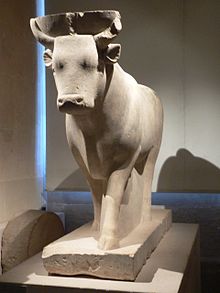Apis bull
| Apis | ||||||||||||
|---|---|---|---|---|---|---|---|---|---|---|---|---|
| Deity representing strength and fertility | ||||||||||||

Statue of Apis, Thirtieth dynasty of Egypt (Louvre)
|
||||||||||||
| Name in hieroglyphs |
|
|||||||||||
| Symbol | Bull | |||||||||||
In Egyptian mythology, Apis or Hapis (alternatively spelled Hapi-ankh, Egyptian hieroglyphs ⟨ḥjpw⟩, reconstructed as Old Egyptian */ˈħujp?w/ (with unknown final vowel) - Middle Egyptian ˈħeʔp(?w), Coptic: ϩⲁⲡⲉ/ⲓ) is a sacred bull worshipped in the Memphis region. Identified as the son of Hathor, a primary deity in the pantheon of Ancient Egypt. Initially, he was assigned a significant role in her worship, being sacrificed and reborn. Later, Apis also served as an intermediary between humans and other powerful deities (originally Ptah, later Osiris, then Atum)."
Apis was very important among all of the sacred animals in Egypt, and, as with the others, this importance increased as time went on. During colonization of a conquered Egypt, Greek and Roman authors had much to say about Apis, the markings by which the black calf was recognized, the manner of his conception by a ray from heaven, his house at Memphis with a court for his disportment, the mode of prognostication from his actions, his death, the mourning at his death, his costly burial, and the rejoicings throughout the country when a new Apis was found. Auguste Mariette's excavation of the Serapeum of Saqqara revealed the tombs of more than sixty animals, ranging from the time of Amenhotep III to that of the Ptolemaic dynasty. At first, each animal was buried in a separate tomb with a chapel built above it.
...
Wikipedia
